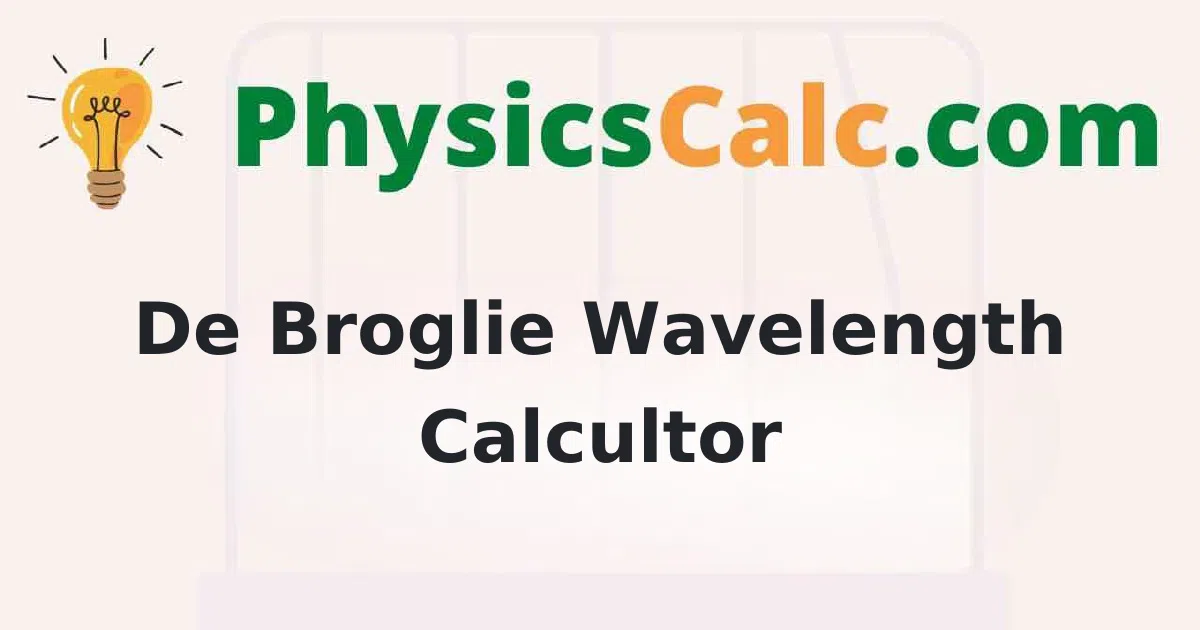De Broglie Wavelength Calculator
This handy de Broglie Wavelength Calculator is used to calculate the wavelength of electrons easily. Just you have to provide velocity and mass of the electron to get the momentum and wavelength values as output easily.
How to Claculate de Broglie Wavelength?
These are the easy steps to compute the wavelength of the electrons. Use these guiding principles to check the output.
- Let us take the electrons velocity and mass
- Multiply the mass and velocity of the electrons
- Divide the constant by the product to get the wavelength
- Divide the constant by the obtained wavelength to see the momentum.
De Broglie Equation
The de Broglie principle states that matter can act as waves just like light can act as particles and waves.
de Broglie equation for wavelength is λ = h/mv and for momentum is λ = h/p
v = h/mλ
p = h/λ
Where,
λ is the wavelength of the electrons
m is the particle mass
v is the velocity of the particle
p is the momentum of the particle
h is the Planck constant and it is 6.26 x 10-34 Js
Example
Question: The de Broglie wavelength of the ekectron is 0.26 nm. Ekectron particle has the mass of 8.06 x 10-31 kg. Calculate the velocity of the electron?
Solution:
Given that
Mass of the electron m = 8.06 x 10-31 kg
Wavelength λ = 0.26 nm
de Broglie equation is λ = h/mv
v = h/mλ
v = 6.63 x 10-34/(8.06 x 10-31 x 0.26)
= 6.63 x 10-34/2.09 x 10-31
= 3.163 x 10-3
Therefore, the velocity of the electron is 3161911 m/s
Want to finish your physics assignments by understanding the concept then go with our free online calculators prevailing on Physicscalc.Com
FAQs on De Broglie Wavelength Calculator
1. What is the De Broglie Wavelength?
De Broglie wavelength is the wavelength in which the object is associated with its mass and momentum. The de Broglie wavelength and object force are inversely proportional to each other. It shows the relationship between wave nature and particle nature of the body.
2. What are the applications of De Broglie waves?
The wave properties of matter are observable for small objects and De Broglie wavelength of double-slit interface pattern is generated using electrons as the source.
3. What is the De Broglie Wavelength of electron formula?
De Broglie wavelength of electron equation is λ = h/mv. Here m is the electron mass and v is the velocity of the electron.
4. What is the wavelength of an electron moving at 5.31 x 106 m/sec?
Given that,
Mass of electron = 9.11 x 10-31 kg
Velocity of electron v = 5.31 x 106 m/s
Planck's constant h = 6.626 x 10-34 Js
de Broglie equation is λ = h/mv
λ = 6.626 x 10-34/(9.11 x 10-31 x 5.31 x 106)
= 6.626 x 10-34/4.84 x 10-24
= 1.37 x 10-10 m
= 1.37 Å
Therefore, the wavelength of the moving electron is 1.37 Å.
1. What is meant by Acceleration? Acceleration is defined as the rate at which object changes.
2. What is initial and final velocity?
Initial velocity means the velocity of an object before it has
3. What is the difference between acceleration and average acceleration?
Acceleration of an object is change in object velocity over an increment of time.
4. Is zero acceleration constant acceleration?
Zero acceleration means there is no change in velocity i.e body is moving with same velocity.
5. What acceleration is needed to accelerate a car from 36 km/h to 72 km/h in 25 seconds?
Initial velocity = 36 km/h = 36 * 1000 m / 3600 s = 10 m/s
Final velocity = 72 km/h = 72 * 1000 m / 3600 s = 20 m/s
time = 25 seconds
Acceleration = (20 - 10) / 25
= 10 / 25 = 0.4 m/s2
